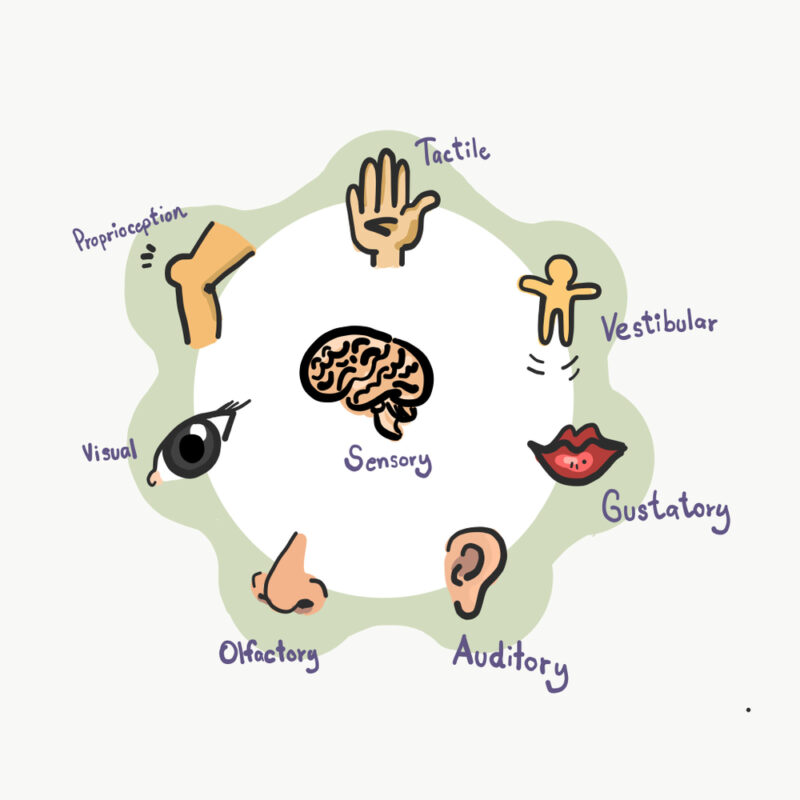What is Sensory Integration?
Sensory Integration (SI) is the way that our senses (sound, touch, sight, smell, and taste) tell us what is happening in our environment through our brain so we can respond to those senses appropriately. The brain organizes and interprets information from our senses making SI crucial as a foundation for more complex learning and behavior.
Sensory Integration challenges (also called Sensory Process Disorder) occur when the person’s body and brain are misinterpreting sensory signals, daily activities and routines are disrupted as a result. SPD is treated by an occupational therapist and it is important to have speech/language therapy to understand sensory processing to support children who struggle with self-regulation, controlling urges to move, make noise or tap on something. At Granite Bay Speech, our therapists are trained to observe and adjust the learning environment to support skill development.
Sensory Process Disorders can present when individuals avoid certain stimuli that others normally do not. For example, some may avoid specific foods, textures, afraid of climbing steps, playing in sand or seams on socks.
Children with sensory processing deficits may have difficulty with motor skills, balance, and eye-hand coordination.
Although SI commonly occurs in people with learning disabilities, intellectual disabilities, language disorders, and those on the autism spectrum, it may also occur alone in individuals.
Speech-language difficulties can co-occur with sensory integration difficulties, thus SI treatment can support speech-language gains.
Sensory Integration concerns may cause mild to severe difficulties socially, academically, and behaviorally. The following are characteristics of difficulties with SI:
- Distracted by sounds not normally noticed by others; (i.e., humming of lights or refrigerators, fans, heaters, or clocks ticking)
- Despite adequate hearing, they may not respond to verbal cues or to their name being called; they are either absorbed due to overstimulation or they are tuning out stimuli
- Appears to “make noise for noise’s sake” (self-stimulation to keep focused or to feel and hear sensory stimuli in an attempt to regulate their sensory system)
- Needs directions repeated often, or will say, “What?” frequently
Here at Granite Bay Speech, we know that individuals integrate information from multiple sensory sources to communicate effectively. Therefore, we strive to align therapy activities to meet the child’s sensory needs. Our goal is to create an environment with the appropriate amount of sensory stimulation to increase learning and language skills. By controlling the stimuli a client is exposed to, we increase a child’s participation, independence and engagement in therapy sessions. We work alongside parents to re-create an appropriate sensory environment so their child continues practicing skills from their therapy session at home.
Our Therapy Rooms are Designed to Reduce Sensory Overload
In order to provide an ideal learning environment, we have installed sound-reducing technology in our walls, ceilings and doors. Our daylight spectrum lighting is non-flickering to improve cognitive performance.
You will notice that we do not post colorful pictures and posters on our walls. Research has indicated cluttered walls are over stimulating, highly distracting and hinder therapy progress.
We Provide Sensory Fidgets to Improve Client Engagement
Fidgets and sensory tools are utilized to ease stress, manage distractions and increase focus for the task at hand.
Our Therapy Rooms have Weighted Tools for Comfort if Needed
Clients are offered weighted shoulder and lap bags to reduce anxiety and help focus. Weighted sensory tools are utilized to provide proprioceptive feedback to clients. The calming effect is believed to come from the feeling of pressure, like a comforting hug. These tools are highly effective for decreasing hyperactivity and improving concentration.


